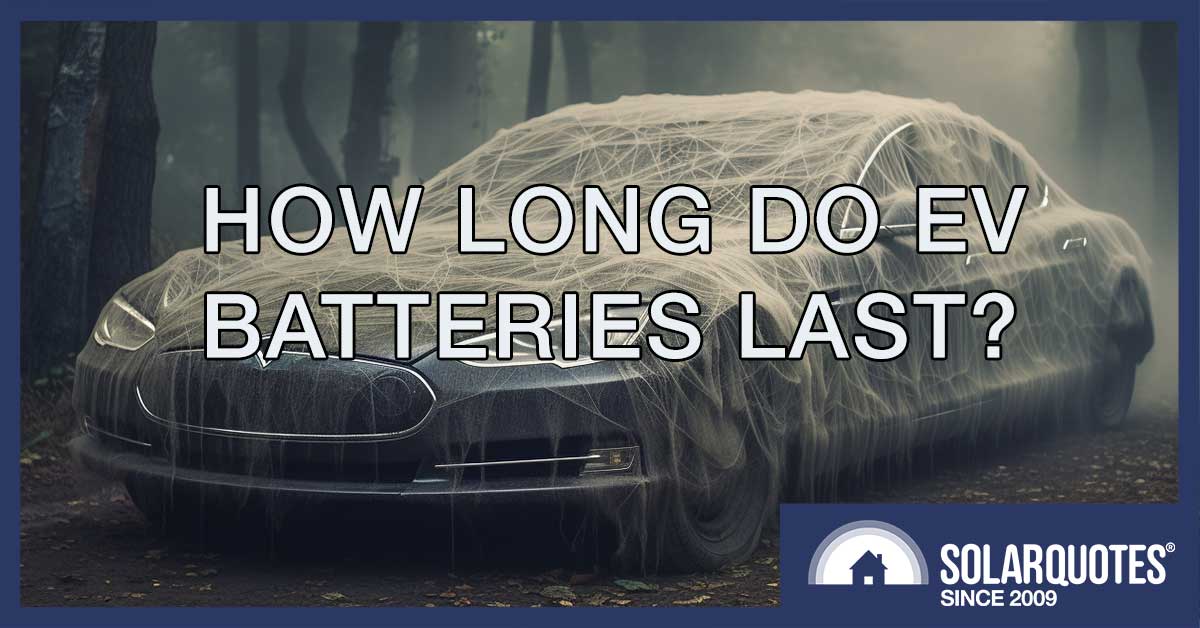
Good news! As your EV gets old, its battery should be fine.
How long do electric vehicle batteries last? According to a study by Recurrent — a US company devoted to helping people buy and sell used EVs — it’s a long time.
Their findings were:
- Not many Electric Vehicles have had batteries replaced so far.
- The decline in range of the EVs look at was modest, even when driving over 160,000km.
- The greatest decline in range normally occurs early in an EV’s life.
The study supports claims by manufacturers that their EVs and their battery packs will last 15-20 years. I’ve previously said the majority of EVs sold today will still have their original batteries in 15 years, so I’m glad they’ve backed me up on this.
You can check out the Recurrent study here. It has some neat graphs and is easy to read, so it doesn’t need to be translated from tech-head.
In this article, I will put their findings into an Australian context, including the liberal use of kilometres instead of miles. I’ll also happily engage in what they seem too polite to do and directly compare the range loss for the EV in the study. I’m throwing the following EVs into the range combat arena:
- Nissan Leaf
- Tesla Model S
- Tesla Model 3
- BMW i3
- Hyundai Ioniq 5
- Ford Mustang Mach-E
The study also looked at the Chevy Volt, but I’m leaving that plug-in hybrid out. Firstly, because it’s not a pure EV and, secondly, only around 250 were sold in Australia as the Holden Volt. Because they’re no longer produced and they stopped putting the steering wheel on the right side a long time ago, we’re not likely to see any more here.
15-20 Years Battery Life?
The study says manufacturers claim their EVs should last 15 to 20 years. While it’s definitely a good thing they don’t give a figure less than that, as an Australian, I have to say that’s a bit piss-weak. Here cars are used for over 21 years on average before they’re scrapped.
Some people mistakingly think cars don’t last that long because they look at the average age of cars on the road which, according to the 2021 motor vehicle census, is 10.6 years. But this means their average age at the end of their life has to be twice that at 21.2 years. That’s basic maths. You’d have to be thick to not immediately realise that. I didn’t immediately realize that when I first saw the average age figures, but I have an excuse. I’m very thick.
But the situation is probably better than the manufacturer’s 15 to 20 year figure suggests. US cars are driven around 21,000km a year; in Australia, the average is only around 13,000km. So for us, it may be more like 24 to 32 years, although that’s very optimistic. While most wear and tear on EV batteries is caused by km driven, some is simply from the passage of time, and that will rack up the older batteries get. Heat can also contribute to deterioration and — with regard to temperature only — Australia isn’t the coolest of countries.
On the bright side, provided the battery holds out, a lot less can go wrong with an electric car than a conventional one. Electric motors are extremely simple and can operate for over 30,000 hours. That’s over 100 years of Oz average annual driving. There’s no exhaust, catalytic converter, oil pump, or mystery belts mechanics always claim need to be replaced. This gives EVs the potential to be very long-lived. So fingers crossed, Australia gets at least 21 years of use from the average EV and its original battery.
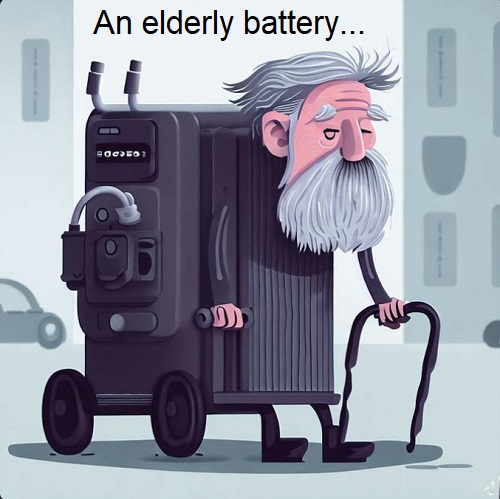
Now I’ve discovered the DALL-E AI image generator, I’m going to fill my articles with vast amounts of visual crap. If there aren’t at least 50 more stupid and awful images below, blame my editor!
Battery Replacements Low So Far
According to the study, only a small portion of EVs have required battery replacements so far. Of the around 15,000 EVs Recurrent keeps tabs on, only 1.5% have had their batteries ripped out and replaced. But there are a couple of reasons why that figure isn’t as good as it seems:
- EVs are still relatively new; in the US, their average age is under six years. But at least it’s longer than here.
- The figure doesn’t include battery replacements from major recalls.
If the average age of cars was 5 years and the 1.5% rate remains constant, then after 20 years, only around 6% of EVs will need battery replacements. Of course, it doesn’t actually work that way, and the older a vehicle gets, the more likely a replacement will be needed. If the 1.5% chance doubles every 5 years then the odds are 22% an EV will need its battery replaced at least once by the time it’s 20 years old.
But I don’t think the figure will turn out that high here. Firstly, the cars in the study have, on average, been driven many more kilometres than the Australian average. Secondly, batteries are still a new technology, and manufacturers constantly work to improve them. There’s good reason to believe future batteries will be far more reliable than the average today. I would also hope and expect that battery packs in EVs sold today are more reliable than the ones in the study.
Recalls Will Continue To Occur
The 1.5% replacement figure doesn’t include large-scale recalls. The largest was for the Chevy Bolt, not sold in Australia. Another big recall was for the Hyundai Kona. This would have affected more Australians, but still not many.
There will be further large recalls in the future. Manufacturers are continually updating battery manufacturing processes. This is necessary to improve batteries, but there will inevitably be mistakes and recalls will occur. As batteries become a more mature technology, recalls will become less common, but I don’t know if we’ll ever be rid of them entirely. Conventional cars still have recalls after over 130 years of practice.
Warranties: Often 8 Years & Many km
If your EV battery is replaced under warranty, that’s annoying but not disastrous. It can even be to your advantage if you end up with a brand-new battery after subjecting your old one to a few years of wear and tear. Most battery pack warranties in the US are for 8 years or 100,000 miles. Whichever comes first. Translated into Australian, that’s 8 metric years or 160,000km. Technically, it should be 160,934km, but it gets rounded down. While that’s not a huge sin, they sometimes “round down” the years. Hyundai offers 10 years or 100,000 miles warranty in the US, but here it’s only 8 years or 160,000km. Hopefully, Hyundai will soon give us 10 years as well. It’s only fair since we’re better looking.
EV Range Loss
The study says the most range loss from battery degradation occurs early in an EV’s life, and the results back this up in all but one case. I’ll give what percentage of range remains when the EVs hit 60,000 miles and, when information’s available, 100,000 miles.
Because there is 1.60934km in a mile and the average annual distance vehicles are driven in Australia is 13,000km, this means:
- 60,000 miles = 96,500km or 7.4 years of average Oz driving.
- 100,000 miles = 161,000 km or 12.4 years of average Oz driving.
Note the EVs in this study have been driven much more than the Australian average each year. This means we should expect greater range loss per km for those driven the Oz average due to the effects of time. The good news is, because the rate of loss flattens off in all EVs studied, the extra range loss — hopefully — will not be great.
All the range percentages I give are average results. There can be considerable variation between individual vehicles.
Nissan Leaf
The Nissan Leaf is the first EV produced on a large scale this century1 and began production in 2010. Over the years, several battery pack capacities have been available.
The largest and newest battery pack is 62 kilowatt-hours (kWh). Because it’s the newest the study only gave information on it up to 125,500km:
- 62kWh Nissan Leaf at 96,500km 95%
- 62kWh Nissan Leaf at 125,500km 95%
The largest battery pack Nissan Leaf held up well and suffered no significant range loss over its final 29,000km.
While the 40kWh Leaf isn’t as new, its results still didn’t reach 161,000km. The study only has information to 153,500km, but that’s 95% of the way, so it’s not far off :
- 40kWh Nissan Leaf at 96,500km 99%
- 40kWh Nissan Leaf at 153,500km 99%
As you can see, the 40kWh Leaf has superb range retention and only lost around 1% of its range after being driven over 150,000km2.
I didn’t expect a great result from the 22kWh Leaf, as the study would have included some of the earliest lithium EV battery packs created. But while it didn’t retain as much range as newer Leafs, it still did well:
- 22kWh Nissan Leaf at 96,500km 93%
- 22kWh Nissan Leaf at 161,000km 91%
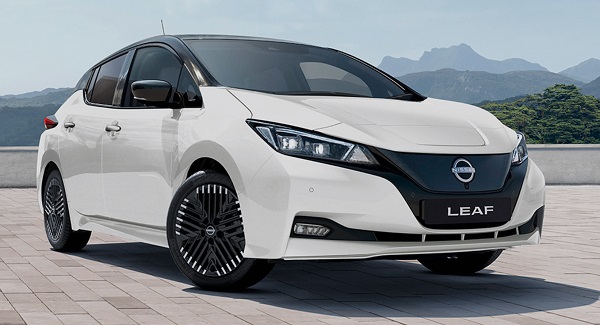
This is a real picture of a real Gen 2 Nissan Leaf. It’s not an AI hallucination. (Image Credit: Nissan)
Tesla Model S
The Tesla Model S has had several battery pack sizes available, and the study looked at the two most common. The largest, and only size available today, is 100kWh. The other is 75kWh. Many of these vehicles were sold with unlimited Tesla supercharging, and so people tended to use that a lot. Because it’s harder on battery packs than a normal home EV charger it may have significantly contributed to range loss, but the study didn’t attempt to quantify this.
The 100kWh battery retained the following amounts of original range:
- 100kWh Tesla Model S at 96,500km: 79% of original range
- 100kWh Tesla Model S at 161,000km: 77% of original range
Losing over 20% of its range before hitting 100,000km surprised me because it’s very different from this graph provided by Tesla:
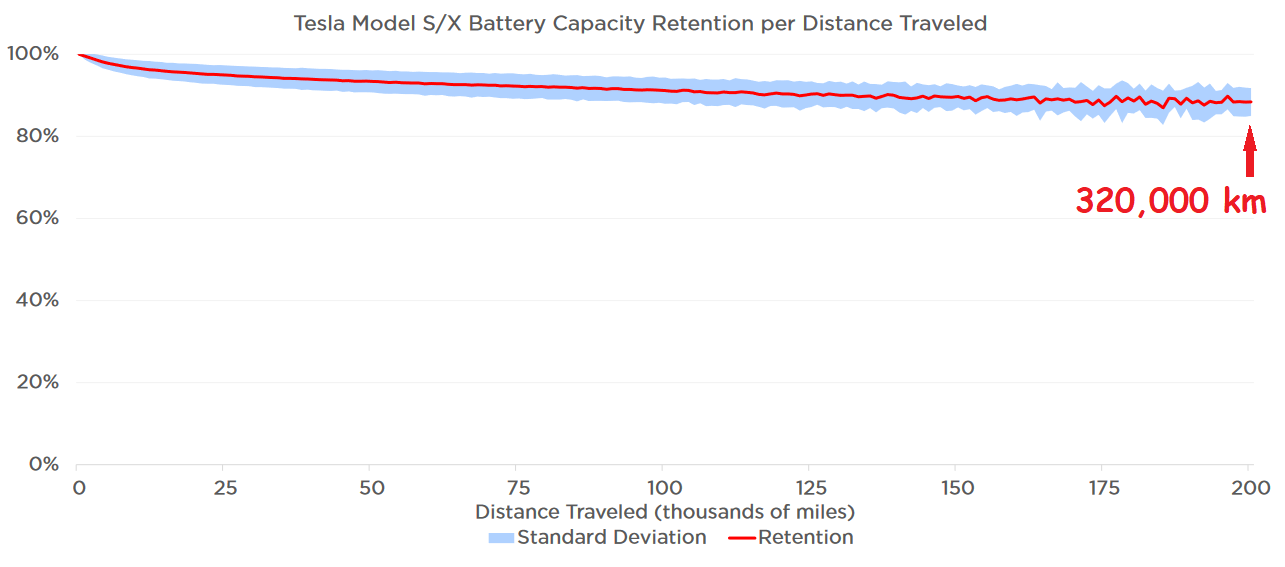
This graph is from page 22 of Tesla’s 2020 Impact Report. They use the same graph in their 2022 Impact Report but made the colours greener. (I added the red arrow and comic sans myself.)
Fortunately, there wasn’t much change over the next 144,000km as the range only dropped down to 77%. So while not nearly as good as Tesla’s graph would suggest, this does suggest the battery will last a long time.
The 75kWh Model S did a lot better:
- 75kWh Model S at 96,500km: 96% of original range
- 75kWh Model S at 161,000km: 92% of original range
Now that’s much more like Tesla’s graph. However, the 75kWh Model S is no longer produced. New ones all have 100kWh battery packs, but it’s not the same as the original 100kWh battery many or most of the vehicles in this study would have had. This makes me hope a 100kWh Model S sold today would suffer range loss similar to or less severe than the 75kWh version.
Tesla Model 3
Tesla Model 3 EVs with 75kWh batteries fared well:
- 75kWh Tesla Model 3 at 96,500km: 93% of original range
- 75kWh Tesla Model 3 at 161,000km: 92% of original range
While they’d lost more range at around 100,000km than the 75kWh Tesla Model S, at 161,000km they were the same.
The 50kWh Model 3 didn’t do as well:
- 50kWh Tesla Model 3 at 96,500km: 84% of original range
- 50kWh Tesla Model 3 at 161,000km: 83% of original range
While its early range loss was considerably worse than its bigger battery brother, there was little loss from 100,000km to 160,000km, which is a good sign.
The version of the 50kWh Model 3 currently sold in Australia is made in Shanghai and has a different battery pack from the American-made ones in this study.3. It uses a different lithium chemistry from the American one, so its range loss may be very different. Because it’s newer, I’ll cross my fingers and hope it suffers less range loss.
BMW i3
Recurrent looked at BMW i3 EVs with 3 battery pack sizes. I’ll give information on the larger 42kWh and 33kWh ones.
Because the 42kWh BMW i3 hasn’t been around that long, the study only gave information up to 88,500km:
- 42kWh BMW i3 at 88,500km: 93% of original range
Because range loss from 50,000km onwards was minimal, it looked likely to still be at 93% at around 100,000km.
Information for the 32kWh BMW i3 didn’t start until it hit 16,000km, so all I can do is indicate how much range was lost from that point on:
- 32kWh BMW i3 at 96,500km: 93% of range at around 16,000km
- 32kWh BMW i3 161,000km: 83% of range at around 16,000km
While the actual range loss is unlikely to be significantly worse than this, it’s impossible to be certain from the study results.
Hyundai Ioniq 5
Information on the Hyundai Ioniq 5 was only available up to 134,500km:
- 77kWh Hyundai Ioniq 5 at 96,500km: 93% of original range
- 77kWh Hyundai Ioniq 5 at 134,500km: 93% of original range
From 50,000km onwards range held extremely steady with no noticeable loss. I hope the battery can maintain this out to 161,000km and beyond.
Ford Mustang Mach-E
The Ford Mustang Mach-E isn’t currently available in Australia but should soon arrive in small numbers. Right-hand drive versions are already on sale in the UK and New Zealand. Clearly, Ford is testing them out in lesser countries to see if their product is worthy of us4. The Premium Rear Wheel Drive Extended Range version has been around in the US long enough for the study to have measured range loss out to 93,500km:
- Ford Mustang Mach-E Premium RWD Extended Range at 93,500km: 99%
After a mild decline, the vehicle’s range began to slowly improve after 45,000km. But there’s nothing strange going on. It’s not a magic pudding battery.

Apparently, this is an Australian magic pudding electric car. If you don’t like it, take it up with Skynet.
As a manufacturer becomes more confident about a new EV and its battery pack, they can send updates that can improve the car’s performance or allow more battery capacity. Over time, the improvements tend to become minor, so don’t expect any miracles from this.
Winners & Not Exactly Losers — 96,500km
Ranking the vehicles’ remaining range from best to worst at 96,500km gives:
- 40kWh Nissan Leaf 99%
- Ford Mustang Mach-E Premium RWD Extended Range 99%?
- 75kWh Tesla Model S 96%
- 62kWh Nissan Leaf 95%
- 22kWh Nissan Leaf 93%, 42kWh BMW i3 93%, 77kWh Hyundai Ioniq 5 93%, 75kWh Tesla Model 3 93%
- 32kWh BMW i3 93%?
- 50kWh Tesla Model 3 84%
- 100kWh Tesla Model S 79%
There’s a question mark next to the Ford Mustang Mach-E because its info only went up to 93,500km. There’s also one next to the 32kWh BMW i3 because we can’t be certain about its range loss. But I think putting the Ford in 2nd and the 32kWh BMW in 6th place is reasonable.
The 40kWh Nissan Leaf took the top spot, and in clear last place was the 100kWh Tesla Model S that only retained 79% of its original range after being driven fewer km than the average Australian car racks up in 8 years. This is in surprising contrast to the 75kWh Tesla Model S, which still retained 96% of its range. So Tesla can clearly make EVs that lose little range. It just doesn’t always happen — at least not in the past.
There were no major losers because, while a couple of Tesla models weren’t great, none of the range loss was excessive. They did well enough to put fossil fool claims about EV range to shame.
Winners & Not Really Losers — 161,000km
When all the EVs that did the distance — or close to it — are ranked from best to worst for range retention at 161,000km, it gives:
- 40kWh Nissan Leaf 99%?
- 75kWh Tesla Model S 92%, 75kWh Tesal Model 3 92%
- 22kWh Nissan Leaf 91%
- 50kWh Model 3 83%
- 32kWh BMW i3 83%?
- 100kWh Tesla Model S 77%
The 40kWh Nissan Leaf has a question mark next to it because its information only went up to 153,500km, but since it retained 99% of its original range while covering 95% of the distance, I think it’s fair to give it 1st place. The 75kWh Tesla Model S did well, taking 2nd place, but the 100kWh version came last with 77% range retention over km, equal to around 12 years of average Australian driving.
The 32kWh BMW i3 has a question mark next to it because it’s impossible to be certain about its range loss. But because I’m confident it did better than the 100kWh Tesla Model S, 5th place seems reasonable.
Minor Range Loss After 50,000km
While there’s considerable variation between EVs, generally speaking, most of the decline in range occurs before 90,000km. For vehicles that went the full distance — as well as the 40kWh Nissan Leaf which nearly did — the range loss between 96,500km and 161,000km — as a percentage and as percentage points5 — was:
- 40kWh Nissan Leaf 0%
- 75kWh Tesla Model 3 1%, 50kWh Tesla Model 3 1% (1 percentage point)
- 22kWh Nissan Leaf 2%, 100kWh Tesla Model S 2% (2 percentage points)
- 75kWh Tesla Model S 4% (4 percentage points)
- 32kWh BMW i3 11% range loss (10 percentage points)
The 40kWh Nissan Leaf only lost a few km of range, which is next to nothing and — after rounding — it is! The only EV without good range retention was the 32kWh BMW i3. The majority had their range drop by ~2% or less over 64,000km or around 5 years of average Australian driving. While there may be some range loss early on, this suggests range loss later in life will be very slow for most EVs.
While it would be nice if this gradual decline continued for decades or millions of km, at some point range loss will either increase or the battery will fail in a more sudden way. Hopefully, this will take a long time to occur in most cases.
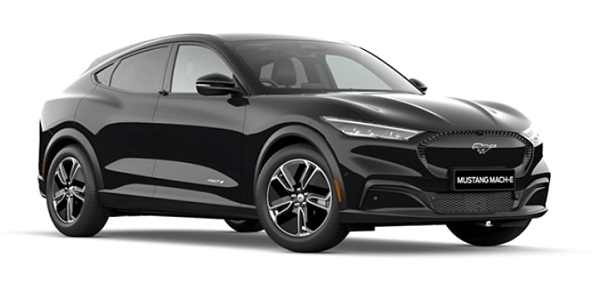
This is what the Ford Mustang Electric looks like. (Image Credit: Ford)
EV Battery Replacement Cost In The US
If an EV battery needs to be replaced while it’s not under warranty, it can be bloody expensive. Recurrent gives US replacement costs on this page. I’ve put the prices they give for 5 EVs below. I’ve converted them directly into Australian dollars at the current exchange rate of 66 US cents to the Dollarydoo. I haven’t tried to adjust them to account for GST or US taxes:
- Nissan Leaf: $8,300-$14,400
- Tesla Model S: $18,200-$33,300
- Tesla Model 3: $24,000
- BMW i3: $3,800-$24,200
- Volkswagen e-Golf: $35,500
As you can see, replacing a battery pack can be extremely expensive even in a country with a more mature EV market like the United States.
At the moment manufacturers pay around $200 per kWh for EV battery packs. That’s $10,000 for a 50kWh pack. When battery packs get down to $100 per kWh, which they eventually will — in today’s money at least — it will only be $5,000. But in the same way it’s nearly impossible to buy a car part at the same price vehicle manufacturers pay, it may be very difficult to get a replacement battery at close to cost.

This isn’t what the Ford Mustang Electric looks like. (Image Credit DALL-E image generator)
How To Improve Things
At the moment, there are a considerable number of subsidies and incentives for EVs in Australia and around the world. If we want to incentivise longer-lasting batteries, governments should consider directing more subsidies towards EVs that have…
- Longer battery pack warranties: I think 10 years should be a minimum for an EV battery pack warranty rather than the 8 years that’s currently typical.
- Longer vehicle warranties: Apart from the battery, there’s not a lot that can wrong with an EV, so it should not be difficult or expensive to provide long warranties for them.
- Minimal or no maintenance requirements: Car companies will be tempted to charge people for maintenance that is not required. This should not be encouraged, as it wastes resources and reduces the value of second-hand vehicles.
- No restrictions on third-party battery replacements: If manufacturers can control which batteries can be used as replacements, or who can replace them, they will jack up prices.
Is Recurrent Gilding The Lily?
The results of the Recurrent study show EVs are generally very good at retaining range even after racking up enough km to travel 44 times the distance between Sydney and Perth. But it is fair enough to wonder — are they incentivised to exaggerate battery longevity? Their goal is to help sell second-hand EVs, so they have a vested interest in portraying EVs as lasting a long time.
Fortunately for my faith in American trustworthiness, which isn’t that high — in part due to someone whose name rhymes with “Elon Musk”6 — their results are similar to what I’ve heard from EV owners online and other sources. So I’m confident they aren’t putting their thumb on the scales.
EV Batteries Can — Usually — Go the Distance
The Recurrent study shows EV batteries can last a long time. While most suffer a modest decrease in capacity early in their life, for all but one EV in the study, it dramatically reduces over time. One vehicle, the 40kWh Nisssan Leaf, suffered only around 1% range loss after travelling over 150,000km, which shows it’s possible to make battery packs that suffer minimal deterioration.
While battery reliability is improving, because the technology is changing rapidly, some people will inevitably get bum batteries that have to be replaced — either as part of mass recalls or in individual vehicles. But as batteries improve in quality, this will happen less often.
Provided a battery replacement occurs under warranty, it’s not a major issue. But if you do have to pay out-of-pocket, it is a serious problem because it’s bloody expensive at the moment, and it may remain so in the future. You can partially protect yourself by ensuring your EV has a good warranty. For most Australians, the number of years a battery warranty has is more important than the number of km covered.
The results of this study, as well as information from other sources, has improved my EV optimism, and I’ll say that I’m confident the majority of EVs sold in Australia today, for household use, will still have their original batteries in 20 years’ time. Unless, of course, they’re all replaced by robo-taxis. Or our robo-masters force us to travel by catapult or something.
Footnotes
- In 1899 the Electric Vehicle Company was the largest motor car manufacturer in the United States. ↩
- I must remember to buy a second-hand one before everyone reads this and the price goes up. ↩
- The Shanghai one has a 57.5kWh battery pack with lithium ferro phosphate (LFP) batteries. The US one was 54kWh in total and NCM, nickel cobalt manganese. ↩
- Lesser, as in less land area. What did you think I meant? Australia is a big country, we need reliable vehicles! ↩
- The 32kWh BMW i3 lost 11% of its range from 96.500km to 161,000km which caused its range loss to decline by 10 percentage points from 93% to 83%. ↩
- Yes, “Elon Musk” rhymes with “Elon Musk”. ↩

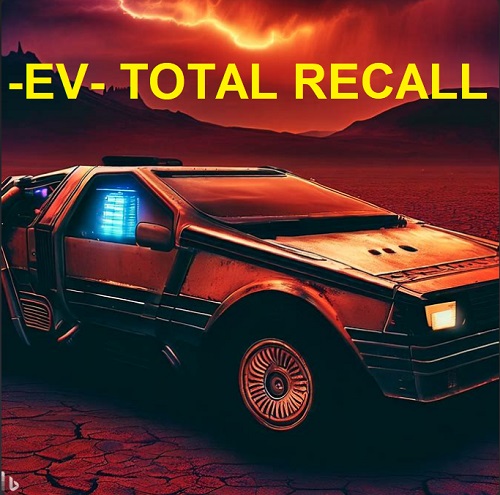
 RSS - Posts
RSS - Posts



The batteries certainly have improved, but not by as much as that data set suggests. My own 24kWh Nissan leaf is down to 56% of it’s original capacity after 97’000km and 12 years. My iMiev is down to 45% after 11 years and 108’000km. My Renault Zoe is down to 84% after 5 years and 131’000km.
The new LFP batteries will do better than the above, both due to having more capacity to start with (and thus don’t have to work as hard), and LFP batteries are more durable anyway.
Goot comment, Matt. I was going to add my own about the Leaf. I have an Ioniq 5, but I know in the UK the consensus is that most 24kWh Leafs have lost half their range. Robert Lewellyn from Fully Charged had that same experience. There are at least two companies in Europe that I know of who sole (and lucrative) business is replacing the batteries in those units with batteries from crashed vehicles. This puts the veracity of this report into some question.
I concur. Our Leaf 30KWh (2016) is down to 8 bars (68% Leafspy) just coming up to 49,000Klm. While it showed 12bars health it was already @ 84% (Leafspy) when we purchased it with 34,000Klm. It does show 300 fast charges prior to purchase. As we have no fast chargers locally it has only been L1/L2 since we purchased. I expect better out of our new M3.
Agreed. The 22kWh Leaf is famous for it’s degradation and there’s a thriving worldwide market retrofitting them with 40kWh batteries from write-offs. I wonder if they got the percentages inverted (100-99 GONE = 91 = 9% LEFT) 🙂 Anyway, it does bring the whole study into question.
Would love to hear of any Australian economical battery swap service for my 2012 Leaf. Bought it 3 years ago with around 28,000 km/90km from full charge, now 33,000km and down to around 75km on a full charge.
Fine for trundling around locally, charging from our solar, but a bit limiting.
Any thoughts out there?
There was a Reddit discussion where someone said they’d used Traction EV in Queensland to do it, and another had contacted them and booked in to do the same. I know they’re being doing in Queensland, and there is a “how to” at https://www.youtube.com/watch?v=zRk_W0O-WUU. Maybe that gives you some leads. I have a nagging suspicion that the hard part will be getting a battery in Australia – there can’t be that many 40kWh Leafs being scrapped with a good battery in them in this country. Probably cheaper just to scrap yours, buy a new 2nd hand one and take the battery out of yours and use it as a house battery, there are some how-to’s out there. Even at 50% you’ve almost got a Tesla Powerwall there.
Excellent article, thank you.
I’ve wondered why Tesla’s warranty on its EVs is so stingy. It sends the wrong message about the quality of the product.
It’s because Tesla is stingy. And they know they can’t allow full access to the battery’s original capacity or it would fail.
With our first car they nerfed the battery capacity before its first summer, so the best we ever saw was close to 400 road km of the originally advertised ‘499 km’
The warranty is 70% of ‘original capacity’, but there’s actually no guarantee that you’ll ever see that ‘original capacity’, even on the day you picked up the car.
That said, we bought anothwr one 4 years later…
Ronald, it is interesting to look at the empty mass of the 75kWh and 100kWh versions of the Tesla model S going back a couple of years. There was little difference (I found 32kg after looking for a while. A friend of mine purchased a new 75kWh version and pointed out that fact to me at the time. He reckoned all the vehicles had the same battery from new with electronically limited charging. To thus day his vehicle continues to show low battery degradation and good range. Maybe the 75kWh model is the one to look for if buying a used EV?
My recollection is that at one point, Tesla was using the same physical packs in the Model S and selling an over-the-air upgrade to unlock additional capacity.
If the customer bought it, Tesla made more money, if the customer stuck with the 75 KWh capacity, and didn’t buy the upgrade, Tesla had a lower probability of a warranty claim.
I also recall reading that some Model 3 ’75 kWh’ packs were a touch over 80 kWh when new, and also limited to 75 by software so the initial degradation would seem less apparent.
My 2c worth: Our Imiev has 130000Km on it, but the battery was replaced under warranty. I think the installation of the new battery was not reset properly in the s/w, because our range only went up from 70Kms to abt 95kms. It now takes about 10Kw, good for 75Kms. Ok for a dhopping trolley…
Our 2020 Kona has 90000Km now & range is still over 450Kms when 100% charged (not often). Realistically, at freeway speeds, we get to Port Macquarie on a 100% charge, a distance of 370Km, & still have enough left to get to the next charger if necessary.
The MG ZS EV Mk 1 owners do not seem to be getting any noteworthy decrease. One found his range had dropped from 263 to 247 km after 80K. That was charging to 100% with a home charger.
Keeping out of dendrite territory might see a range of 200km per charge.
That would be 15,000 cycles over 3,000,000Km.
Sounds legit. Sort of like saying an unserviceable timing chain will last the lifetime of the engine.
This begs the question of what is the warranty when the vehicle is used for commercial purposes. With ICE cars and utilities they generally half the warranty kms and services are done more frequently. both my Commadore station wagons did 500,000 klm with no major repairs but scrupulous servicing. Can someone please read their EV handbook and tell us what it says about commercial use of the vehicle.
I’ve been through both the BYD and Tesla warranty and can see no commercial exclusions. I assume that like all warranties service will be more frequent as you follow the kilometre schedule and the warranty will expire earlier as it’s 160,000kms or the time period, whichever comes first. BYD has a bunch of stuff outside the powertrain that it’s excluded from it’s 8 year and 6 year terms which is disappointing. Many things inside the cabin are only warranted for 4 years. The service schedule offers two options – a commercial user would be taking the higher kilometre one.
Tesla doesn’t actually have a service schedule. The motor and battery coolant is designed to last the lifetime of the warranty. However, common sense would say rotate the tyres every 10,000K and check the coolant occasionally for signs of deterioration and check the normal suspension components and brakes every 12 months. Change the wiper blades and air filters every 6 – 12 months. In countries with very wet conditions and road salt the brakes on all EVs are subject to regular inspection as they get used infrequently. It’s probably good practice to make sure you engage the friction brakes at least once a week,
None of these warranties exclude your rights under Australian Consumer Law. That would be illegal.
“However, common sense would say rotate the tyres every 10,000K and check the coolant occasionally for signs of deterioration and check the normal suspension components and brakes every 12 months.”
From memory EVs don’t need brake servicing as much, because of the use of regenerative braking?
Brake servicing is like insurance. You only wish you had it when you need it. Brakes are used less with an EV because of regen but that means less wear, but it can be a negative too as you can get glazed disks and other issues. It’s important to use the physical brake from time to time (I turn my regen low once a week or so for one trip, though my Ioniq 5 has an auto regen mode which is more efficient than iPedal – hard to believe – but still uses the brake a little).
Even with regen fully on, you’ll use the brakes at least a few times per trip so glazing won’t be an issue.
well I don’t think those Nissan LEAF statistics are right or it’s a very limited sample set. Sort of debunks the whole survey. They didn’t sell that many in Australia back in 2014 but of the early ones (24kWh) they did sell most suffered catastrophic range loss. More like 50% than the figures quoted in the article.
Perhaps they have no way of telling if a vehicle has already had it’s pack replaced when it comes on to their books? Apart from that, for the most part I agree with their findings. EV batteries will last a long time.
OK, having read the article I understand now as Ronald left out a very important codicil about the LEAF.
From the Recurrent article:
“However, it is important to note that the cars in the Recurrent fleet may skew newer than the average age of cars on the road. This is especially true for the Nissan LEAF, since early models lack the telematic services that we use for our data connection.”
I also noted that the LEAF had the most battery replacements outside of the recalls. As they can’t really check early LEAFs I think the high number of battery replacements is directly related to inadequate cooling and high temperatures.
Sorry Ronald but I think your usually impeccable logic is a bit flawed on these statements – ” the average age of cars on the road … is 10.6 years. But this means their average age at the end of their life has to be twice that at 21.2 years. That’s basic maths.” As any student of stats will tell you thats only true if age distribution curve is evenly distributed and thats certainly not true for vehicle age. Obviously the minimum age is 0 but the maximum age is open ended and there are a reasonable number of really old cars floating around to give a really long tail to the distribution. The median vehicle age (ie half will be older and half will be younger) will be a year or two less than the average vehicle age.
I bow my head in shame.
The maximum age isn’t open ended. Cares have only been around for 120 years, so the maximum age is 120, though amusingly electric cars have been around almost that long, too. The median age is half the range but you can’t say anything about the average on this basis. The average age of cars on the road is the age of each car all added together and divided by the total number of cars. Cars rust, they crash, they do burnouts and get crushed, and they get converted into trailers. Or pink and chrome just go out of fashion. So, there will be more younger cars than older ones, which skews the average towards the younger end. Also, more cars were made in recent years than in years past (almost twice as many in 2016 compared to 1999 according to Worldometer), which will also push the average towards the younger end, even if every car ever made was still running, which I have a suspicion isn’t the case. Ronald is also quoting someone else here, and they didn’t give details of how they calculated that, so his maths is ok.
I wonder what happens if people start to use V2G capability, and the impact on both range and how vehicle manufacturers view the battery warranty status. Is anyone looking at the fine print in warrantly details?
Don’t. Why wear your battery further using V2G. Manage your power usage at home in a better way so the penalty of not using it is minimal.
I’m one of those approximately 250 Australian owners of a Holden Volt. Bought it second hand about 6 years ago. It’s around 10 years old. Its relatively small battery (it is a PHEV) is still in excellent condition. I get around 62 km on a full charge, same as it was 6 years ago. GM really built a great car. People I showed it to went on to buy electric.
I have a 2012 Nissan Leaf 24kWh, bought 2nd hand 3 yrs ago with 29,000kms.
It then got to around 90kms range on a charge. Now 33,000 and only 70kms range!
But good for local runabout to shopping, golf etc.
My last info was new battery about $12-14,000, had to be ordered from Japan!
I do not think I’ll bother, just drive it till it or I stop! As 2nd hand value with new Bat might be not much more than its cost.
Any other older Leaf owners/replaced batteries/cost & experience?
Hans a question if I may. Does it take less power to charge the battery as the batteries capacity reduces? I see articles about reusing older EV batteries for solar produced power home storage but have not seen anything about the batteries efficiency as its capacity degrades over time.
I’m not Hans, but yes, it takes less energy to charge as it’s capacity degrades, but it’s not a proportional effect (ie if the battery degrades by 20% the amount of energy it takes to fill it might only go down by 18%). This is due to the various things that cause degradation. One of them is that the internal resistance increases over time, which means that you get increased heat loss as you charge (ie the charging becomes less efficient). Another side effect is that charging time actually increases as the battery degrades – you get less charge and it is less efficient and takes longer.
Indeed that is my experience, but that in itself does not cause a major issue as we have solar panels and battery. So I charge during the day every second or third day or so.
Thanks, Hans. I should add for the casual reader that these effects are small in modern EVs, this just an explanation of the process. It might sound alarming to the inexperienced! 🙂
Thank you both. That the charging efficiency falls makes sense and I was interested in quantifying the loss.
You’re welcom, Ian. I should note that the numbers I gave you are off the top of my head. It’s not my area of expertise (I’m an electronics engineer and do work with Lithium batteries, but I’m not a battery engineer). The actual numbers will vary a LOT with different batteries. Modern EVs, as this story shows, don’t suffer much from this degradation, whereas cheap 18650 Lithium cells are impacted much more. The things that will affect the loss are:
– battery chemistry (eg LiIon vs LiFe vs NiMH vs NiCd)
– environment (extremes of heat of cold)
– usage profile
– Battery management systems (this is why EVs last a long time).
NISSAN LEAF stats 99% garbage.
Sorry to be rude, but who cares about the leaf. They sold hardly any of them (about 2500). They are old and use batteries which degrade quickly because they are stressed and too small tor the weight of the car.
Most of the battery tech used in the report is over 10 years and technology has moved on since then. The fact these results are ok based on batteries that are old, is encouraging. Much newer cars will fare noticeably better.